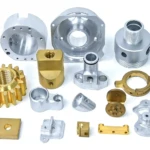Introduction to Advanced Heat Exchangers: Revolutionizing Thermal Management with 3D Printing
The realm of thermal management has witnessed a significant paradigm shift with the advent of additive manufacturing (AM) technology. Researchers from the University of Illinois in Urbana-Champaign have successfully developed a compact water condenser that outperforms traditional heat exchanger conceptions, leveraging the capabilities of 3D printing. This innovative approach has far-reaching implications for various industries, including HVAC, automotive, data centers, and aviation, where efficient thermal management is paramount.
Optimized Internal Geometric Structure through 3D Printing
The condenser, printed using the Alsi10mg alloy through laser powder fusion technology, boasts a complex internal geometric structure that cannot be achieved through traditional manufacturing methods. This structure features a V-shaped flow spoiler on the refrigerant side and a corrugated cross-shaped fin on the water side, designed to enhance turbulence and increase local heat transfer coefficients. The ability to precisely adjust the internal structure enables effective management of flow, pressure drop, and thermal resistance in multiple fluid paths, setting it apart from traditional heat exchangers based on stacked plates or fin tubes.
Multipass Cross-Flow Architecture for Compact Performance
The condenser employs a multipass cross-flow architecture to optimize heat exchange between water and the refrigerant within a compact footprint. The cross-flow configuration allows the two fluids to flow perpendicular to each other, enhancing thermal contact on the internal surface of the heat exchanger. Multiple parallel flow paths in each fluid area increase the surface area and improve flow distribution. Water and refrigerant are directed through several consecutive stages of the condenser, with the refrigerant passing through four traits that gradually shrink the passage to compensate for its increase in density during the condensation process. Meanwhile, water flows in opposite directions in its own four-track circuit, enabling precise control of fluid velocity, pressure drop, and thermal gradients.
Simulation-Driven Optimization and Machine Learning Integration
To optimize the condenser’s performance, the research team combined two-dimensional finite element simulation with a machine learning model trained on 36,000 configured fin shapes. This model predicts the effectiveness of fins and factors for improving input areas at a physically segmented thermal model. Design candidates were identified through parameter analysis and refined using computational fluid dynamics (CFD) to verify local temperature, velocity, and pressure distributions.
Experimental Verification in a Customized Steam Compression Loop
The prototype was experimentally tested in a customized steam compression loop, demonstrating a heat transfer rate of 3 kW to 8 kW within the refrigerant saturation temperature range of 35°C to 49°C. The water side flow was tested between 5 and 40 liters per minute. The model-based and CFD results corresponded to experimental data within a 5% precision range, validating the reliability of the simulation framework.
Compatibility with Low GWP Refrigerants
Although R134A was initially tested, the study evaluated the performance of other refrigerants, including R1234YF, R32, propane, and isobutane, which have lower global warming potential (GWP) than R134A. Simulations showed that at higher flows, R32 has twice the heat transfer rate as R134A, while propane and R1234YF have similar or slightly improved performance.
Prospects for Additive Thermal Components
This study demonstrates a proven design method for creating compact and efficient heat exchangers using AM. The ability to refine thermal resistance, flow paths, and geometry at the segmented level, combined with validated CFD and experimental results, makes this approach suitable for real-world applications in HVAC, automotive, data center, and aviation systems. The design of the condenser contributes to the growing research and commercial development of heat exchangers reshaped by 3D printing.
Industry Developments and Future Directions
Recent studies, such as the one conducted by Lawrence Livermore National Laboratory (LLNL), have explored the use of metallic 3D printing to create miniaturized heat exchangers for electronics and aviation applications. Companies like Conflux Technology are actively working on 3D printed heat exchangers, having raised 11 million euros in series B financing to expand their production using laser powder fusion technology. The company has also collaborated with Rocket Factory Augsburg to integrate 3D printed heat exchangers into orbital rockets, demonstrating the relevance of AM in producing components that can withstand extreme conditions. Other efforts, such as Ge Research’s development of a 3D-shaped heat exchanger capable of operating at 900°C, exceed the temperature limit of existing solutions by over 200°C, showcasing the flexibility of additive manufacturing in thermal management systems and the advantages of applying specific conceptions.
The future of thermal management looks promising, with 3D printing poised to revolutionize the design and production of heat exchangers. As research and development continue to advance, we can expect to see more innovative applications of additive manufacturing in various industries, enabling the creation of compact, efficient, and high-performance thermal management systems.

















